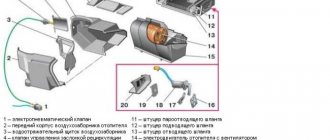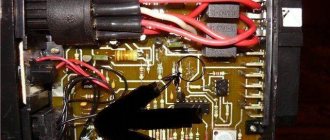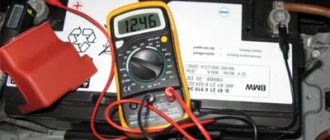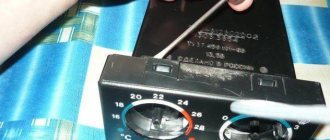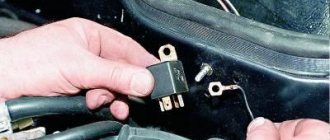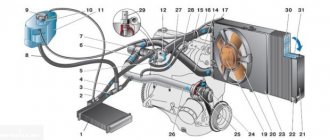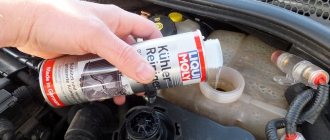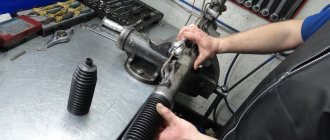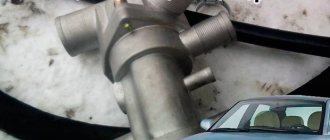In the summer, as a rule, car owners do not think much about the operation of the heater, and only realize it if they already need to turn on the interior heating, and it turns out that the VAZ 2110 heater does not heat well, or even does not work at all.
The driver turns the control knob, sets it to the “hottest” position, but the stove works weakly, it’s cold in the cabin, the windows fog up and all this forces the native auto industry to “shut down.”
Heater device VAZ 2110
However, problems often arise due to the fact that the owner of the VAZ 2110 simply did not worry about the normal operation of the stove in time, and is now intensely asking the question: why does it heat poorly, and how to deal with it?
Heating system design
The VAZ 2110's interior heating system has its own differences. First of all, it should be noted that the system works separately.
It is represented directly by the heater - a stove that prepares warm air entering the cabin through pipes - heat distributors. Air ducts lead into the cabin, where hot air flows directly from the control panel, and also blows on the windows or is directed to the driver and passenger's feet.
Control parts and air ducts of the VAZ 2110 stove
All this is controlled by a unit for regulating the air flow and its temperature (heating), that is, an air distributor. The VAZ 2110 stove has one more difference from others - it has an evaporator.
How to replace the radiator of a VAZ 2110 stove - step-by-step instructions
We replace the heater radiator as follows:
Replacing an old-style heater core
To replace the old-style VAZ-2110 heater radiator, the windshield trim with rubber seal is initially dismantled. To remove it, first unscrew the lining mounting bolt under the brake cylinder and the four bolts for its upper fixation on the passenger side. Next, the clamps with which the pipes and hoses are secured are dismantled.
Then be sure to disconnect the fan electrical wires from the vehicle body. After carrying out such manipulations, access to two fasteners on the driver's side of the windshield trim will open. They need to be dismantled, after which you can move the frill slightly forward. You don't need to remove it completely. Then the remaining nuts and bolts that hold the windshield trim are unscrewed. After this, the plastic lining between the windshield and the engine compartment can be completely removed.
Next, it is important to disconnect the terminal of the sensor, which indicates the coolant level, and remove the steam drain hose from the expansion tank. Subsequently, it is necessary to remove one by one the windshield washer hose, windshield wipers, fasteners on the heater housing, the front block of the fan housing, the fan, the cabin air purifier, the remaining part of the fan housing and all hoses of the heating system
After this, you can easily pull out the radiator housing.
The next stage of work is replacing the failed heat exchanger with a new part and installing all dismantled elements in their original places
When assembling, focus on installing the plastic fan housing
It is important that the pedal fits into the appropriate slot, otherwise the vehicle heater will not function
It is also necessary to check the condition of the cabin filter; it may also need to be replaced. If there are visible defects on the pipes and hoses, they must be replaced. Make sure that all connecting clamps and fasteners ensure a tight fit of the parts, otherwise you will not get any heat in the vehicle interior. At this point, the replacement of the stove radiator can be considered complete.
Replacing a new heater radiator
Replacing the radiator of a new VAZ-2110 stove has features related to the method of connecting the heat exchanger to the vehicle body. In order to dismantle the part, you will need to unscrew the central bolt in the lower segment of the windshield. Then unscrew two nuts above the intake manifold and one near the cabin filter on the left. The next step is to remove the air filter, which is attached to the stove with four screws.
The modified heater is formed from two parts, which are connected by three self-tapping screws. You need to unscrew the large self-tapping screw and two additional bolts that connect the components of the stove. After this, the right component of the stove is moved to the right to its maximum possible position. Holding the left segment with your hand, you need to stretch the right side, turning it towards you and lifting it up. Next you can remove the left side of the stove. A hose for removing steam is led through the passage of the soundproof shield.
The right segment of the stove is divided into two more components. To separate the right side, you need to remove the mounting brackets. The right side of the stove can then be opened without significant effort. The heater dampers will open to view, and it is also advisable to replace them. The best option for this would be aluminum valves, which are wear-resistant and less subject to deformation.
The last stage of work is installing a new part and assembling all elements of the heating system in the reverse order. Make sure that all connections are well tightened, as this will significantly affect the functionality of the interior heating system.
Possible faults
Everyone wants to ride in a warm car, and you can’t argue with that. Therefore, we will consider possible malfunctions, and then ways to eliminate them.
So, repairs are required if the VAZ 2110:
- The heater temperature cannot be adjusted;
- Only cold air blows, and something clicks under the hood;
- A heater radiator leak has been detected;
- The temperature sensor located on the ceiling does not work;
- The ACS control unit is broken.
You can read more about possible malfunctions of the VAZ 2110 stove here:
The stove doesn't blow at all, what's the problem?
If the heater fails, you can do the initial fault diagnosis yourself.
Unfortunately, the complex heater control system has not proven itself as a device that allows you to take the hassle off the driver and automatically maintain the set temperature. Instead, we got a lot of trouble and cold interiors in the frost. Let's go from simple to complex and first let's look at the problems with the electric heater motor. Everything is more or less simple here:
- Fuse. We turn on the stove, it doesn’t work. If we were lucky, the fuse had blown. Finding it is as easy as shelling pears, it is more difficult to find out the reason for its burnout. The 25-amp fuse F18 is located in the main mounting block; it also protects the circuit for the glove compartment lighting, heated rear window and is partially related to the cigarette lighter, so it is easy to diagnose its failure. And in order to find the short circuit that caused it to burn out, you will have to call all these circuits - the glove compartment light, the rear window heating, the headlight washer and the cigarette lighter.
Heater fuse location.
- Contacts. A very common occurrence on the VAZ 2110 is the lack of contact on the heater control unit or on the electric motor itself, there is no contact on the power wire on the automatic control system. You will have to go through and clean all these contacts.
We check the contacts on the heater control unit and the electric motor.
- Stove blower. The electric motor of the stove also does not last forever and can either simply burn out or fail for another reason. To check its operation, we get to its power supply contacts and measure the voltage. If we record 12 V at the engine input, the problem is in the engine. The brushes may be worn out or burnt, the motor commutator may have burned out, or the winding may have burned out or shorted out. In any case, no one will bother with it, we’ll just replace the electric motor with a new one.
Checking the automatic heater control system
The stove control system can also give out surprises. They consist in the fact that one of the speeds may not work, several, or only one, the most powerful, may work. At the same time, the SAUO block is not universal and is selected depending on the year of manufacture of the car:
One of the reasons for the failure of the stove may be the unit of the automatic heater control system.
- 2110-8128020-03, price 2300 rubles, used in the last ten years of production;
- 21102-8121020, price 3100 rubles, installed on cars with air conditioning;
- 2110-8128020-02, about 2 thousand, set for the first ten years of production;
- 2110-8128020-01, 1840 rubles, used on some cars before the year 2000.
Temperature is not adjustable
There can be two reasons for such a malfunction: either the control unit malfunctions, or the damper does not work. First of all, check the temperature sensor (it is located on the ceiling near the ceiling lamp).
To do this, scroll the temperature control lever several times from the extreme “cold” position to the extreme “hot”. In addition, you can check the temperature simply by feeling.
Air temperature sensor in the cabin of VAZ 2110
If warm air begins to flow only when the sensor is set to the extreme “hot” position, it means that it is not working and needs to be changed.
Problem solving
Now let's talk about how to solve emerging issues, troubleshoot problems and return the heater to normal operation.
Each breakdown requires separate consideration.
Broken motor
Temperature not regulated
If the temperature of the air flows cannot be adjusted, the problem is hidden in the control unit or damper, or the temperature sensor on the ceiling inside the cabin does not work.
To check, turn the regulator all the way to the right and place your hand under the air flow. If warm air flows only when the regulator is in the maximum heating position, change the sensor. If that doesn't help, change the regulator. If heat is received in other positions of the regulator, the sensor should not be blamed.
Be sure to check that the damper is not stuck. It can be accessed through the engine compartment. If replacement is necessary, replace the standard plastic damper with an aluminum product. It is more durable.
Blowing cold
If the heater on your VAZ 2110 starts blowing cold air, you need to look for the reasons. The cause of the failure lies in the gear motor. A similar situation occurs in 9 out of 10 cases, so it is unlikely that you will have to look for alternative culprits.
Air flows with a broken damper
The gearmotor needs to be replaced. This is done as follows:
- Wipers are removed;
- The frill is dismantled;
- Unscrew the three screws that hold the gearmotor;
- The wiring is disconnected;
- A new one is installed in place of the failed device. Ask your assistant to switch the position modes of the regulator, and at this moment you will mount the gearmotor;
- The frill and wipers are returned to their place. Work is done.
But there is 1 case out of 10 that will force you to change the heater due to wear and tear of the old one. As the practice of VAZ 2110 owners shows, the heater from 2112 is best suited for replacement. Moreover, you can choose between two stove options - 2112-01 or 2112-02. The first one does not have an air filter, while the second option has one.
The windows fog up, the feet are not heated
It is not uncommon for VAZ models to have a problem when air flows normally from the stove, but it does not heat the feet and does not flow onto the windows.
Modification of air ducts
The issue can be resolved by upgrading your air ducts and getting rid of existing gaps in the cabin and warm air intake channels. This is a rather complicated procedure, the implementation of which will allow you to forget for a very long time about the problem with the stove, which does not warm your feet and does not blow on the side windows.
It would not be superfluous to install a pre-start heater. Due to it, the interior warms up faster.
Coolant leaks
The stove may not heat up due to the fact that the level of coolant, that is, coolant, decreases. Do not rush to add antifreeze to the tank. First, be sure to check for signs of leakage in the pipes and connections.
Problems with the stove on a VAZ 2110
If your radiator is leaking, the news is not good for you. You will have to dismantle it and, most likely, replace it with a new one.
The heater is very noisy
Many owners of the domestic “ten” are faced with a situation where a working stove makes a lot of noise. In this case, everything works fine, air flows spread throughout the cabin in the same way as the regulators are set.
The noise does not affect efficiency, but it becomes seriously annoying over time. Sometimes it seems that the stove will be covered with a copper basin, although it can make noise for a long time without consequences for the integrity of the device.
Let's try to figure out why it makes noise.
- If the noise is similar to a squeal, or the sounds are sharp, check the fastening of the lower part of the stove. The fact is that fastening is carried out using hooks that can come off. This is what makes the noise.
- The heater body sometimes gets damaged by the protrusions holding the retainer. In this case, the housing simply needs to be replaced with a new one.
- If the fan itself is noisy, remove it, clean it, and check the condition of the electric motor.
- The textolite washers, which are designed to prevent axial play of the fan, may also hum. Any low friction washers will be suitable as a replacement. For example, elements made of fluoroplastic. Be sure to lubricate the washer. Some people use regular machine oil, but it really only gives a temporary effect. The best lubricant in this case would be thick graphite grease or lithol.
Damper repair or replacement
It happens that the damper is “stuck” - that is, it stops turning due to the fact that the fastenings have oxidized and have not been looked at for a long time.
In the VAZ 2110, you can only “get close” to the damper from under the hood. First you need to remove the deflectors, then bend the antennae. Now try to move the flap by hand.
If it works and “walks” easily, then the reason is something else. But in any case, knowledgeable car enthusiasts recommend replacing the plastic damper with an aluminum one.
This small modification allows for better heat retention, the stove will work better, since, plus, there will be no deformation, which plastic dampers are prone to.
The subtleties and nuances of damper repair are outlined here:
Damper micromotor
The micromotor for the damper drive is located under the hood near the windshield. You need to remove the frill and insulation to get to the motor. If the lever “moves” when the warm air supply is turned on, it means it’s working.
But it often happens that the gears wear out and “slip”, then it is better to replace this motor. Some craftsmen open the damper manually, without this motor, and they drive like that.
However, in this case, hot air will constantly be blown out, that is, such a “repair” is only possible as a temporary measure.
Leaking radiator
It is possible that the heater on the VAZ 2110 is not working well due to a leak in the radiator. You add antifreeze, which may help for a while, but then the stove starts acting up again. Why is this happening?
Check the radiator for integrity. This is one of the most difficult tasks regarding the heating system, since in order to get to the radiator, the stove must also be removed.
If the radiator is bad, then it is better to replace it rather than try to solder it. This may not last long, but there is a lot of hassle with disassembly and assembly.
Heater fan not working
It is quite simple to understand that the car's heater fan is faulty. To do this, just start the car and switch the heater operating mode. If during the switching process no additional sounds appear in the vehicle interior, this means that the heating system fan is not working. At the same time, if the fan does not spin only at certain speeds, then the problem is not in the fan itself, but either in the resistor or in the heating intensity toggle switch.
The stove fan does not work - the main reasons
There are six main reasons why the stove fan may not work:
1. The fuse has blown.
This is the most banal and simple reason, but at the same time the most problematic. The thing is that replacing a fuse is a very simple procedure that anyone, even the least experienced car owner, can handle. But it’s very difficult to identify the short circuit that caused it to burn out. To do this, you will have to go through the entire electrical circuit of the car's interior heating system.
Video. The fan on the VAZ 2110 does not work
It is worth noting that the fuse marked F7, which has a current strength of 30 amperes, is responsible for the operation of the stove. Note that the same fuse is responsible for the glove compartment lighting, the cigarette lighter, the rear window heating system, as well as the electric headlight washer motor. This means that if you do not find the cause of the short circuit in the electrical circuit of the heater, you will have to go through almost the entire wiring of the vehicle.
2. Poor quality contact inside the mounting block.
Oxidation of the contacts inside the mounting block is a very common cause of stove fan malfunction. To make sure of this, you need to move the block on which the flagella are attached; if the fan starts working, then remove it and clean the contacts.
3. Flooding the relay of the vehicle ignition system.
This problem is diagnosed quite simply. If your heater starts working only after the car has “warmed up”, then the reason is in the ignition relay. The only way to fix this problem is to replace the relay. It is located under the dashboard.
4. The stove only works at third speed.
In this case, the problem is related to the additional resistor. The thing is that at speeds 1 and 2, electric current is supplied to the fan through a resistor, and at speed 3, it is supplied to it directly. There is only one solution in this case - replacing the additional resistor of the heating system of the car interior.
Let us recall that in the previous article we looked at how to replace brake fluid with your own hands. This process must be performed regularly, according to the manufacturer's recommendations.
5. The vehicle interior heating system switch is faulty.
To check this switch, you should dismantle the center console, start the car, take a 12-volt marker light bulb with soldered wires and short the negative wire from it to the body, and touch the second to contacts 1, 2 and 3 of the additional resistor. If the light bulb is on, then the switch is working, and if not, then connect the wire of the light bulb to the positive terminal of the switch. If it does not light up, then the culprit is an open circuit or a blown fuse.
6. The electric fan motor does not work.
When you have checked all the previous options, but have not identified any problems, then there are only three reasons why the stove fan does not spin: - the electric motor has burned out - the electric motor has poor contact with the ground of the car - the brushes of the electric motor have become stuck.
Insulation
Sometimes hot air does not flow well to the feet and side windows. Although the stove works fine, for some reason my feet are cold, and the side windows are foggy. Even if you install a new corrugation, it is unlikely to help much.
It is also necessary to eliminate all the cracks so that the warm air does not fight with the cold air, but goes straight to the target. Everything on the panel needs to be sealed with anti-squeak, and in some places with polyurethane foam, which will not creak and will also help retain heat for a while.
